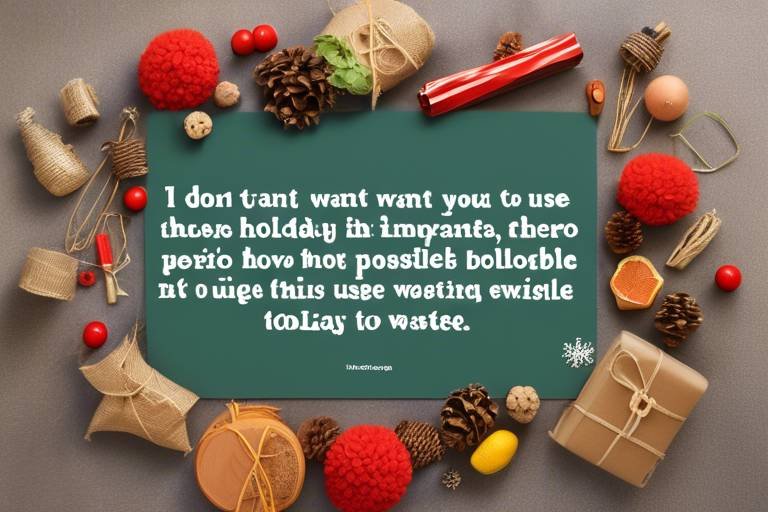Is it Possible to Have Zero Waste Holidays?
As the holiday season approaches, many of us find ourselves caught in a whirlwind of festivities, decorations, and gift-giving. But have you ever stopped to consider the environmental impact of these joyous celebrations? The idea of zero waste holidays might sound daunting, but it’s not only possible—it's also incredibly rewarding! Imagine celebrating with loved ones while consciously minimizing waste and making sustainable choices. It’s like throwing a party that not only fills your heart with joy but also nurtures the planet.
So, what does a zero waste holiday look like? It’s about embracing the spirit of giving and togetherness while being mindful of our consumption. Instead of mindlessly purchasing gifts and decorations that will end up in landfills, we can opt for thoughtful, sustainable alternatives. This shift in mindset can transform our celebrations into meaningful experiences that honor both our traditions and our environment.
To embark on this journey, we need to rethink our holiday practices. Start by evaluating the materials you use, the food you serve, and the gifts you give. Every small change counts, whether it’s using reusable decorations or choosing to give experiences instead of physical items. It’s about creating a ripple effect—when you choose to celebrate sustainably, you inspire others to do the same. Imagine a world where every holiday season brings not just joy to our hearts but also a positive impact on our planet!
Throughout this article, we’ll explore practical tips and ideas to help you achieve a zero waste holiday. From eco-friendly invitations and decorations to sustainable gift-giving and waste-free meals, you’ll discover how easy and enjoyable it can be to celebrate while caring for our Earth. So, grab a cup of hot cocoa, get cozy, and let’s dive into the world of zero waste festivities!
- What is a zero waste holiday? A zero waste holiday focuses on minimizing waste during celebrations by making sustainable choices in areas like gift-giving, food, and decorations.
- How can I reduce waste when giving gifts? Consider giving experiences, homemade gifts, or items made from sustainable materials.
- Are zero waste holidays expensive? Not necessarily! While some sustainable options may have a higher upfront cost, many zero waste practices save money in the long run.
- Can I still have fun during a zero waste holiday? Absolutely! Celebrating sustainably can be just as joyful and meaningful, often leading to more memorable experiences.

Understanding Zero Waste Philosophy
The zero waste philosophy is more than just a trendy buzzword; it’s a transformative approach to how we live our lives, especially during the holidays. At its core, this philosophy champions the idea of minimizing waste by rethinking our consumption habits. Imagine a world where every celebration is not only joyful but also sustainable—this is the essence of zero waste. It encourages us to embrace practices that reduce our environmental impact while still allowing us to enjoy the festivities that bring us together.
So, how does one get started with this philosophy? It begins with understanding the five key principles that guide zero waste living:
- Refuse: Say no to what you don’t need. This can include unnecessary gifts, plastic straws, or single-use items.
- Reduce: Minimize what you do need. Focus on quality over quantity—choose items that are durable and long-lasting.
- Reuse: Give a second life to items instead of throwing them away. Think of how you can repurpose decorations or gifts.
- Recycle: Ensure that you recycle materials properly. This means knowing what can be recycled in your area and doing it right.
- Rot: Compost organic waste. This not only reduces landfill waste but also enriches the soil.
By adopting these principles, we can transform our holiday practices. For instance, instead of buying new decorations every year, consider using natural materials like pinecones, leaves, or even homemade ornaments. These not only add a personal touch but also minimize waste. Additionally, when it comes to gift-giving, think about experiences rather than physical items. This not only creates lasting memories but also aligns perfectly with the zero waste ethos.
Furthermore, the zero waste philosophy encourages us to engage in meaningful conversations about sustainability with our friends and family. It’s not just about cutting down on waste; it’s about fostering a culture of mindfulness and responsibility. When we share our experiences and tips, we inspire others to join the movement, creating a ripple effect that can lead to significant change.
As we navigate through the holiday season, let’s challenge ourselves to rethink our traditions. Can we swap out plastic wrapping paper for reusable fabric wraps? What about hosting potluck dinners where everyone brings a dish to share, thus minimizing food waste? The possibilities are endless, and the impact can be profound.
In conclusion, embracing the zero waste philosophy during the holidays doesn’t mean sacrificing joy or tradition. Instead, it invites us to celebrate in a way that honors our planet and future generations. By making small changes, we can create a more sustainable holiday experience that is both fulfilling and environmentally friendly.

Planning Sustainable Celebrations
When it comes to planning a holiday celebration, the excitement can sometimes overshadow the environmental impact of our choices. However, embracing a zero waste mindset doesn’t mean sacrificing joy or tradition. In fact, it can enhance your celebrations in ways you might not have imagined! By being intentional about how you organize your gatherings, you can create unforgettable experiences that are both festive and sustainable.
First things first: effective planning is crucial. Start by considering every aspect of your celebration, from the invitations to the decorations and the food. Each element provides an opportunity to minimize waste and make eco-friendly choices. For example, instead of traditional paper invitations that often end up in the trash, think about sending out digital invites. Not only are they stylish and modern, but they also save trees and reduce your carbon footprint. There are numerous platforms that allow you to customize your invites, making them as festive as you want while being kind to the environment.
Next, let’s talk about decorations. It’s easy to get carried away with glittery, single-use items that look great but ultimately contribute to landfill waste. Instead, consider using natural materials and reusable items. Think about creating a centerpiece with pinecones, dried fruits, or even seasonal flowers that can be composted afterward. You could also host a DIY decoration party with friends where everyone brings items from home, like old ornaments or fabric scraps, to create something new and beautiful together. This not only reduces waste but also adds a personal touch to your decor.
When planning the menu, aim for dishes that are not only delicious but also sustainable. Consider sourcing ingredients from local farmers' markets or choosing seasonal produce, which often requires less energy to grow and transport. This is a fantastic way to support your community while ensuring that your meals are fresh and flavorful. Additionally, think about portion control to avoid excess food waste. It’s better to have smaller servings that can be refilled than to have a mountain of leftovers that might not get eaten. And speaking of leftovers, don't forget to have a plan for any food that remains after the festivities!
In summary, planning sustainable celebrations is all about being mindful and intentional. By making small changes, like opting for digital invites, using natural decorations, and sourcing local ingredients, you can host a holiday gathering that is not just enjoyable but also environmentally responsible. Your guests will appreciate the thoughtfulness behind your choices, and you’ll feel good knowing that you contributed to a healthier planet while making lasting memories.
- What are some easy ways to reduce waste during holiday celebrations?
Start with digital invitations, use reusable decorations, and plan meals carefully to minimize leftovers. - How can I involve my guests in sustainable practices?
Encourage them to bring their own reusable containers for leftovers and suggest carpooling to reduce travel emissions. - Are there specific themes that work well for zero waste celebrations?
Themes like "Nature's Bounty" or "Vintage Charm" can inspire decorations and menus that are both beautiful and eco-friendly.

Eco-Friendly Invitations
When it comes to planning a zero waste holiday celebration, one of the first things to consider is how you invite your guests. Traditional paper invitations, while charming, often end up in the trash, contributing to unnecessary waste. Instead, why not embrace the digital age and opt for ? Not only do they reduce paper waste, but they also offer a creative canvas to express your festive spirit.
Digital invitations come in various forms, from beautifully designed e-cards to personalized emails. You can use platforms like Evite, Paperless Post, or even social media events to send out your invites. These options allow for customization, enabling you to incorporate your holiday theme while keeping it stylish and engaging. Plus, they often come with RSVP tracking features, making it easier to manage your guest list.
But what if you want to add a personal touch? Consider creating a short video message or an animated invitation. You can showcase your excitement for the event, share what guests can expect, and even highlight your commitment to sustainability. This approach not only makes your invitation memorable but also sets the tone for a festive gathering focused on environmental consciousness.
For those who still cherish the tactile feel of paper, there are sustainable alternatives. Look for invitations made from recycled materials or seed paper that can be planted after the celebration. This way, your guests can enjoy a beautiful bloom in their garden as a reminder of the fun time spent together. You can also collaborate with local artisans who specialize in eco-friendly stationery, supporting your community while minimizing your environmental impact.
In summary, eco-friendly invitations are not just about reducing waste; they are about enhancing the overall experience of your holiday celebrations. By choosing digital options or sustainable paper products, you can spread the word about your gathering while staying true to the principles of zero waste. So, the next time you plan a holiday event, remember that your choice of invitations can set the stage for a more sustainable celebration.
- What are eco-friendly invitations? Eco-friendly invitations are digital or sustainably made paper invitations that minimize waste and environmental impact.
- How can I create a digital invitation? You can use online platforms like Evite or Paperless Post, or design your own using graphic design tools.
- Are paper invitations completely out of the question? Not at all! You can opt for recycled or seed paper invitations to keep it sustainable.
- Can I personalize digital invitations? Yes! Many digital invitation services allow for extensive customization to match your holiday theme.

Waste-Free Decorations
When it comes to celebrating the holidays, decorations are often the first thing that comes to mind. However, traditional decorations can lead to a significant amount of waste, from single-use items to synthetic materials that don’t biodegrade. But fear not! You can create a stunning and festive atmosphere without contributing to the landfill. Imagine walking into a room adorned with natural elements and handmade crafts that not only look beautiful but also tell a story about sustainability. Let’s dive into some creative ideas for waste-free decorations that will make your holidays merry and bright!
First off, consider using natural materials that are both eco-friendly and biodegradable. Think about crafting centerpieces from pinecones, branches, and dried fruits. These items can be easily sourced from your backyard or local park, and they bring a touch of nature indoors. You might even find that they add a delightful scent to your space, reminiscent of a cozy winter forest. To enhance the festive vibe, you can sprinkle some cinnamon sticks or star anise around your arrangements.
Another fantastic waste-free decoration idea is to utilize reusable items that you already own. For instance, why not repurpose your old holiday cards into unique garlands? Simply cut them into shapes like stars or trees, string them together with twine, and hang them up for a charming display. This not only saves money but also adds a personal touch to your decor. Plus, it’s a wonderful way to reminisce about past celebrations as you look at the cards from loved ones.
If you're feeling particularly crafty, consider embarking on some DIY projects. You can create beautiful ornaments from materials like glass jars, fabric scraps, or even old magazines. Imagine turning a stack of forgotten magazines into colorful paper chains that drape elegantly around your home. Not only does this keep waste out of landfills, but it also allows you to express your creativity and style. Who knew that waste could be transformed into such eye-catching decor?
For those who prefer a more minimalist approach, live plants can serve as stunning decorations. Potted herbs or small evergreens can be used to liven up your space and can be enjoyed long after the holidays are over. You can even decorate them with organic twine or biodegradable ornaments that won’t harm the environment. Plus, they can be a lovely addition to your home décor year-round.
Finally, consider incorporating experiences into your decorations. Instead of physical items, focus on creating an ambiance that encourages connection and joy. Set up a space for storytelling, where family and friends can gather to share their favorite holiday memories. You can even create a “memory wall” where everyone can write down their favorite moments from the past year on biodegradable paper and hang them up for all to see.
In conclusion, waste-free decorations are not just a trend; they are a way to celebrate the holidays while showing respect for our planet. By choosing natural materials, repurposing items, engaging in DIY crafts, using live plants, and focusing on experiences, you can create a festive atmosphere that is both beautiful and sustainable. So this holiday season, challenge yourself to think outside the box and embrace the joy of eco-friendly decorating!
- What are some easy DIY decoration ideas for holidays? You can create garlands from old holiday cards, use natural elements like pinecones and branches, or make ornaments from glass jars and fabric scraps.
- How can I incorporate live plants into my holiday decor? Use potted herbs or small evergreens as centerpieces or decorations. They can be adorned with biodegradable ornaments and enjoyed long after the holidays.
- Are there any sustainable alternatives to traditional holiday decorations? Yes! Consider using reusable items, natural materials, and DIY crafts to create beautiful decorations without contributing to waste.

Sustainable Gift Giving
When the holiday season rolls around, many of us feel the pressure to shower our loved ones with gifts. However, this tradition often leads to an avalanche of waste, from excess packaging to items that may end up collecting dust. But fear not! Embracing doesn’t mean you have to sacrifice joy or creativity. Instead, it’s about thoughtfulness and being mindful of our impact on the planet.
One of the most effective ways to give sustainably is by choosing gifts that are not only meaningful but also environmentally friendly. Think about what your loved ones truly value. Are they passionate about experiences rather than material possessions? If so, consider gifting them experiential gifts like cooking classes, concert tickets, or a day out in nature. These gifts create lasting memories without adding to the clutter in their homes.
Another fantastic approach is to delve into the world of DIY and upcycled gifts. Imagine the delight on a friend’s face when they receive a hand-knitted scarf or a set of homemade candles made from repurposed materials. Not only do these gifts showcase your creativity and effort, but they also tell a story of sustainability. You can even host a DIY gift-making party with friends, turning the act of creating gifts into a fun, shared experience.
When it comes to selecting gifts, consider local artisans or businesses that prioritize sustainability. By supporting local, you’re not just reducing the carbon footprint associated with shipping products long distances; you’re also investing in your community. Plus, many local creators offer unique, handcrafted items that can’t be found in mainstream stores, making your gift even more special.
As you navigate the world of sustainable gift giving, you might find it helpful to keep a few key principles in mind:
- Quality over Quantity: Opt for fewer, high-quality items that will last longer.
- Personalization: Tailor your gifts to the recipient’s interests and needs.
- Eco-Friendly Packaging: Use recycled materials or reusable bags instead of traditional wrapping paper.
By focusing on these principles, you can ensure that your holiday gifting aligns with the zero waste philosophy, promoting a more sustainable future while still spreading joy. Remember, it’s not about how much you spend, but the thought and care that goes into each gift that truly counts.
Q: What are some examples of sustainable gifts?
A: Sustainable gifts can include items made from recycled materials, local artisan products, experiences like cooking classes or concert tickets, and DIY gifts made from upcycled materials.
Q: How can I ensure my gift is eco-friendly?
A: Look for gifts that are made from sustainable materials, support local businesses, and come with minimal or no packaging. Additionally, consider giving experiences instead of physical items.
Q: Is it okay to give second-hand gifts?
A: Absolutely! Second-hand gifts can be unique and meaningful, and they help reduce waste by giving new life to items that might otherwise be discarded.
Q: How can I wrap gifts sustainably?
A: Use recycled paper, fabric scraps, or reusable containers. You can also get creative with old newspapers or maps for a vintage look!

Experiential Gifts
When it comes to gift-giving, the idea of is like a breath of fresh air in a room filled with clutter. Instead of wrapping up another gadget or trinket that might end up collecting dust, why not consider giving your loved ones the gift of memories? Experiential gifts focus on creating moments that last a lifetime, and they align perfectly with the zero waste philosophy. Think about it: experiences such as cooking classes, concert tickets, or a weekend getaway create joy without the physical waste that often accompanies traditional gifts.
Imagine gifting your friend a pottery class where they can unleash their creativity, or a wine tasting tour that allows them to indulge their palate while supporting local vineyards. These gifts not only provide enjoyment but also foster connections and create stories that can be cherished forever. Plus, they often support local businesses, making your gift even more meaningful.
Here are a few ideas for experiential gifts that can spark joy and excitement:
- Cooking Classes: Perfect for foodies or anyone looking to enhance their culinary skills.
- Adventure Activities: Think skydiving, rock climbing, or zip-lining for the thrill-seekers in your life.
- Concerts or Shows: Tickets to see their favorite band or a local theater production can provide unforgettable nights.
- Wellness Retreats: A day at a spa or a yoga retreat can be a wonderful way to relax and rejuvenate.
- Travel Experiences: Plan a weekend getaway or a day trip to explore a new city or nature trail together.
The beauty of experiential gifts lies in their ability to create connections and foster relationships. They encourage shared experiences, which can be more valuable than any material possession. When you gift an experience, you’re not just giving a ticket or a class; you’re offering the chance to create lasting memories together. So, the next time you’re contemplating what to get someone, remember that the best gifts can’t be wrapped—they can only be experienced.
In a world where we are constantly bombarded with advertisements for the latest gadgets and trends, choosing experiential gifts can feel like a revolutionary act. It’s a way to step back from consumerism and embrace a lifestyle that values meaningful connections over material possessions. So, let’s celebrate the holidays with gifts that resonate on a deeper level, ensuring that our celebrations are not only joyful but also environmentally responsible.
Q: What are experiential gifts?
A: Experiential gifts are gifts that focus on experiences rather than physical items. They can include activities like classes, concerts, travel, and more.
Q: Why are experiential gifts considered more sustainable?
A: They typically create less waste compared to traditional gifts, as they don’t result in physical items that may be discarded or unused.
Q: How can I personalize an experiential gift?
A: You can tailor the experience to the recipient’s interests or hobbies, making it more meaningful. For instance, if they love cooking, a gourmet cooking class would be perfect.
Q: Are experiential gifts suitable for all occasions?
A: Absolutely! They can be great for birthdays, holidays, anniversaries, or just to show someone you care.

DIY and Upcycled Gifts
When it comes to gift-giving during the holidays, nothing says "I care" quite like a DIY or upcycled gift. Creating a gift from scratch or repurposing something you already have not only adds a personal touch but also aligns perfectly with the zero waste philosophy. Imagine the joy on your loved one's face when they receive something unique, crafted with love, and devoid of excessive packaging. It's a win-win!
One of the most beautiful aspects of DIY gifts is that they can be tailored to the recipient's interests. For instance, if you have a friend who loves to cook, consider making a personalized spice jar set. You can collect small glass jars, fill them with various spices, and label them creatively. This not only reduces waste by reusing jars but also adds a touch of flair to their kitchen. Alternatively, you can create a handmade coupon book offering services like babysitting, home-cooked meals, or even a coffee date. This way, the gift is not just a physical item but also an experience, which is often more cherished.
Upcycling is another fantastic avenue for sustainable gifting. Instead of tossing out old clothes, think about how you can transform them into something new. For example, an old sweater can be turned into cozy mittens or a stylish tote bag. The possibilities are endless! You can even host a small upcycling party with friends, where everyone brings items to repurpose. Not only will this reduce waste, but it will also foster creativity and collaboration.
For those who enjoy crafting, consider making homemade candles or bath bombs. These can be made from simple ingredients and packaged in reused containers, such as old teacups or jars. The warmth of a candle or the relaxation from a bath bomb can be a thoughtful gift that shows you care about their well-being.
As you embark on your DIY and upcycled gift journey, remember that the essence of these gifts lies in the thought and effort you put into them. It's not about spending a lot of money; it's about creating something meaningful. So gather your materials, let your imagination run wild, and prepare to spread joy this holiday season with gifts that are as sustainable as they are heartfelt.
- What are some easy DIY gift ideas? You can create personalized photo albums, homemade jams, or even knitted scarves. The key is to choose something that reflects the recipient's personality.
- How can I ensure my upcycled gifts are high quality? Focus on using clean, sturdy materials and take your time in the crafting process to ensure the final product is something you'll be proud to give.
- Can kids participate in making DIY gifts? Absolutely! DIY projects can be a fun family activity. Simple crafts like painted pots or decorated picture frames are great for kids.

Waste-Free Holiday Meals
When it comes to the holiday season, one of the biggest culprits of waste is undoubtedly food. Think about it: how many times have you found yourself tossing out half-eaten dishes or leftover ingredients after the festivities? The good news is that with a little bit of planning and creativity, you can create that not only satisfy your taste buds but also respect the planet. Imagine hosting a gathering where every dish is savored and nothing goes to waste – sounds like a dream, right? Well, it can be your reality!
To kick things off, let's talk about smart shopping strategies. Before you even step foot in the grocery store, make a list of what you actually need. This simple step can prevent impulse buys that often lead to excess food. Additionally, consider buying in bulk, especially for non-perishable items. Not only does this help reduce packaging waste, but it can also save you money in the long run. And don't forget to support local farmers by choosing seasonal ingredients. Not only are they fresher and tastier, but they also have a smaller carbon footprint compared to imported goods.
Now, once you have your ingredients, the real fun begins: cooking! One of the best ways to minimize waste is by practicing portion control. It's tempting to prepare a feast that could feed an army, but remember, smaller portions mean less waste. You can always offer seconds! And if you do end up with leftovers, don’t fret – they can be transformed into delightful new meals. Think of it as a culinary adventure! For instance, leftover roasted vegetables can be tossed into a hearty soup, while extra turkey can be used for sandwiches or salads. The possibilities are endless!
Speaking of leftovers, let’s dive into some creative leftover ideas. Here are a few innovative recipes that might just inspire you:
- Turkey Tetrazzini: A creamy pasta dish that uses leftover turkey and can be made with whatever vegetables you have on hand.
- Stuffing Waffles: Mix leftover stuffing with eggs and cook them in a waffle iron for a fun breakfast twist.
- Vegetable Frittata: Combine various leftover veggies and eggs for a quick and nutritious meal.
By embracing these strategies, you not only reduce waste but also create a more enjoyable and fulfilling holiday experience. Imagine gathering around the table with friends and family, sharing delicious meals made from wholesome ingredients, and knowing that every bite counts. This holiday season, let’s make a commitment to honor our planet while celebrating together. After all, isn’t that what the holidays are all about?
Q: How can I ensure my holiday meals are truly waste-free?
A: Start by planning your menu carefully, make a shopping list, and buy only what you need. Consider portion sizes and get creative with leftovers to minimize waste.
Q: What should I do with leftover food?
A: Leftover food can often be transformed into new meals. For example, you can make soups, casseroles, or even sandwiches. Be sure to store leftovers properly to keep them fresh.
Q: Are there any eco-friendly alternatives for holiday cooking?
A: Absolutely! Use seasonal ingredients from local farmers, opt for organic products when possible, and consider plant-based options to reduce your environmental impact.

Smart Shopping Strategies
When it comes to embracing a zero waste holiday, the way we shop plays a crucial role in minimizing our environmental impact. It’s not just about what you buy, but how you buy it. Imagine walking through a bustling market, surrounded by vibrant colors and fresh produce, knowing that every choice you make is a step towards sustainability. To kick off your eco-friendly shopping spree, start with a well-thought-out plan. Making a shopping list is not just a mundane task; it’s your battle plan against impulse buys that lead to waste. By jotting down exactly what you need, you’ll avoid the temptation of unnecessary purchases that often end up in the trash.
Next, consider buying in bulk. Not only does this approach reduce packaging waste, but it also allows you to purchase exactly the amount you need. Many local stores and co-ops offer bulk bins filled with grains, nuts, and spices, which can be a treasure trove for your holiday cooking. Plus, bringing your own containers to fill up is a small act that makes a big difference. Think of it as bringing your own canvas bag to the grocery store; it’s a simple action that contributes to a larger cause.
Another strategy is to focus on seasonal ingredients. Not only do these ingredients taste better, but they also support local farmers and reduce the carbon footprint associated with transporting food long distances. Picture biting into a juicy, ripe tomato in the summer or savoring the earthy flavors of root vegetables in the winter. When you shop for seasonal produce, you’re not just eating fresh; you’re participating in a sustainable food system. Additionally, visiting local farmers' markets can be a delightful experience. You get to meet the people who grow your food, learn about their practices, and often find unique items that you wouldn’t see in a standard grocery store.
While you’re at it, don’t forget to check your pantry before heading out. It’s easy to forget what you already have tucked away in the back of your shelves. By taking stock of your ingredients, you can plan meals that utilize what you already own, further reducing waste. Imagine crafting a delicious holiday feast from a mix of pantry staples and fresh finds, all while keeping your waste to a minimum. It’s like a fun puzzle that results in a fantastic meal!
In summary, smart shopping for a zero waste holiday involves a combination of planning, bulk purchasing, seasonal selections, and utilizing what you already have. By adopting these strategies, you not only enhance your holiday experience but also contribute to a healthier planet. So, the next time you prepare for a festive gathering, remember that every small choice can lead to significant change.
- What is zero waste shopping? Zero waste shopping focuses on reducing waste by opting for bulk items, reusable containers, and seasonal produce.
- How can I reduce food waste during holidays? Plan your meals, shop with a list, and utilize leftovers creatively to minimize food waste.
- Are there specific stores that support zero waste shopping? Yes, many local co-ops and farmers' markets promote bulk buying and sustainable practices.

Creative Leftover Ideas
After the holiday festivities wind down, many of us are left with a fridge full of delicious leftovers. Instead of letting that food go to waste, why not get creative and transform those remnants into exciting new meals? It's like giving your holiday feast a second life! One of the best parts of cooking is experimenting, and leftovers can be the perfect canvas for your culinary creativity. Think of it as a fun challenge: how can you take what's already there and make it something new and delightful?
For instance, leftover roasted vegetables can be repurposed into a vibrant veggie stir-fry. Just chop them up, toss them in a hot pan with some soy sauce, garlic, and a sprinkle of sesame seeds, and you've got a quick meal that’s not only tasty but also colorful! Similarly, if you have extra mashed potatoes, consider making potato pancakes. Just mix them with an egg, some flour, and your favorite herbs, then fry them up until they're golden brown. Voila! You've turned yesterday's side dish into today's crispy delight.
And let’s not forget about those holiday meats! Leftover turkey or ham can easily be transformed into hearty soups or sandwiches. A simple turkey soup can be made by simmering the meat with some broth, vegetables, and spices. It’s a warm, comforting dish that’s perfect for chilly winter nights. Alternatively, you could whip up some turkey sandwiches with cranberry sauce for a festive twist on a classic meal. The key is to think outside the box and let your imagination run wild!
To help you brainstorm even more ideas, here’s a quick table of common holiday leftovers and some creative ways to use them:
| Leftover | Creative Idea |
|---|---|
| Roasted Vegetables | Veggie Stir-Fry |
| Mash Potatoes | Potato Pancakes |
| Turkey | Turkey Soup or Sandwiches |
| Stuffing | Stuffed Peppers |
| Cranberry Sauce | Cranberry Smoothie |
Another fun way to use up leftovers is to create a “leftover buffet.” This is especially great if you have friends or family over. Set out all the leftover dishes and let everyone build their own plates. It’s interactive, fun, and a great way to ensure that nothing goes to waste. You might even discover some unexpected flavor combinations that become new favorites!
Remember, the goal is to minimize waste while maximizing flavor and enjoyment. By thinking creatively and being resourceful, you can turn what might seem like a burden into a delightful culinary adventure. So, next time you find yourself staring at a fridge full of holiday leftovers, embrace the challenge! Who knows? You might just become the leftover master in your household.
Q: How can I store leftovers properly to ensure they last longer?
A: Make sure to store leftovers in airtight containers and refrigerate them within two hours of cooking. Label the containers with dates to keep track of freshness.
Q: Can I freeze leftover food?
A: Yes! Many leftovers can be frozen for later use. Just ensure they are in freezer-safe containers and consumed within three months for the best quality.
Q: What are some quick meals I can make with leftovers?
A: Some quick meal ideas include stir-fries, soups, casseroles, and sandwiches. The key is to mix and match ingredients creatively!
Frequently Asked Questions
- What does zero waste mean during the holidays?
Zero waste during the holidays refers to the practice of minimizing waste generated from celebrations, decorations, gifts, and meals. It encourages individuals to rethink their consumption habits and opt for sustainable choices that reduce environmental impact.
- How can I plan a sustainable holiday gathering?
Planning a sustainable holiday gathering involves several steps, such as sending digital invitations, using reusable decorations, and preparing a menu that emphasizes local and seasonal ingredients. It's all about being mindful of the resources you use and aiming for minimal waste.
- What are some eco-friendly alternatives for holiday decorations?
You can create beautiful holiday decorations using natural materials like pinecones, leaves, and branches. Additionally, consider DIY projects that utilize items you already have at home or opt for decorations that can be reused year after year.
- How can I give gifts without creating waste?
To give gifts sustainably, consider experiential gifts like tickets to events or classes, which create lasting memories without physical clutter. Alternatively, handmade gifts or upcycled items can add a personal touch while being eco-friendly.
- What are some tips for reducing food waste during holiday meals?
Reducing food waste during holiday meals can be achieved by planning your menu carefully, shopping with a list, and being mindful of portion sizes. Additionally, get creative with leftovers by transforming them into new dishes to minimize waste.
- Can I still enjoy holiday traditions while being zero waste?
Absolutely! You can enjoy holiday traditions while being zero waste by adapting them to be more sustainable. This might mean using eco-friendly materials for decorations or choosing gifts that are meaningful and sustainable, ensuring that the joy of the season remains intact.



















